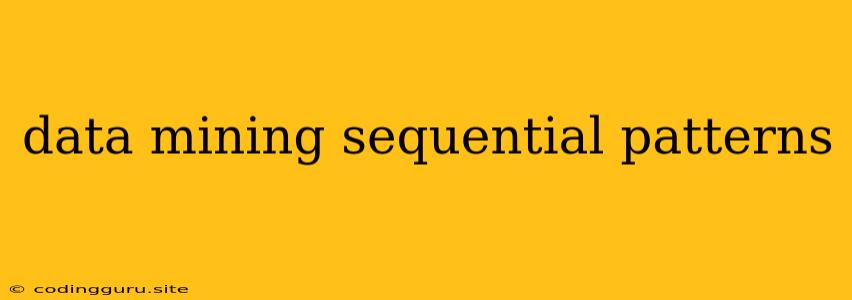Understanding the Secrets of Sequences: A Guide to Data Mining Sequential Patterns
In the realm of data analysis, understanding patterns is key. But what about patterns that unfold over time, like a story? This is where data mining sequential patterns comes in. It's a powerful technique for uncovering hidden trends and relationships within sequences of events, enabling us to understand not just what happened but also when it happened and what might happen next.
Why are Sequential Patterns So Important?
Imagine you're a business owner. Wouldn't you love to know which products customers tend to buy together, or how their buying habits change over time? Or perhaps you're a researcher analyzing patient records. Understanding the sequence of symptoms leading to a diagnosis could be crucial. These are just a few examples of how data mining sequential patterns can be applied across various fields.
So, how does it work?
Data mining sequential patterns is about finding statistically significant recurring patterns in datasets where order matters. Think of it as uncovering the story hidden within the data. Here's how it typically works:
- Data Collection: We gather the data that holds the sequences we want to analyze. This could be website visits, customer transactions, medical records, or anything that unfolds over time.
- Preprocessing: The data is cleaned and transformed to ensure it's in a format suitable for pattern mining. This involves handling missing values, standardizing data types, and potentially discretizing continuous variables.
- Pattern Discovery: This is the heart of data mining sequential patterns, where algorithms like Apriori, GSP, or PrefixSpan are employed to identify frequent and statistically significant patterns. These algorithms use techniques like support and confidence to evaluate the strength of the patterns discovered.
- Pattern Interpretation: The final step involves analyzing and interpreting the discovered patterns to gain insights into the data. This might involve identifying associations, predicting future events, or making recommendations.
Examples of Data Mining Sequential Patterns in Action
- E-commerce: Identifying customer buying sequences to personalize recommendations and improve marketing strategies. For example, a customer who buys a new phone might be interested in a screen protector or a case soon after.
- Healthcare: Analyzing patient records to understand the progression of diseases, identify risk factors, or predict potential complications. For example, a sequence of high blood pressure readings followed by a sudden spike might indicate a potential heart attack.
- Social Media: Understanding trending topics and user behavior based on posts, interactions, and engagement patterns over time. This can be used to optimize content creation, community building, or even predict future trends.
- Financial Markets: Analyzing stock price fluctuations to identify trading opportunities or predicting market crashes. For example, certain sequential patterns in stock prices might indicate upcoming market volatility.
Tips for Successfully Mining Sequential Patterns
- Choose the right algorithm: Different algorithms excel at different tasks. Consider the size of your dataset, the type of patterns you're looking for, and the computational resources available.
- Define your goals clearly: What are you hoping to achieve by mining sequential patterns? This will guide your data preparation, algorithm selection, and interpretation of results.
- Preprocess your data carefully: Ensure your data is clean, complete, and consistent for accurate pattern discovery.
- Validate your findings: Ensure the patterns you discover are statistically significant and not just random occurrences.
- Communicate your insights effectively: Use visualizations, narratives, and clear language to convey your findings to stakeholders.
Conclusion
Data mining sequential patterns is a valuable technique for unlocking insights from time-series data, allowing us to understand the dynamics of events and predict future outcomes. Whether you're in business, healthcare, finance, or social media, mastering this technique can lead to better decision-making and innovative solutions. By exploring the story within your data, you can unlock hidden patterns and gain a deeper understanding of the world around you.
